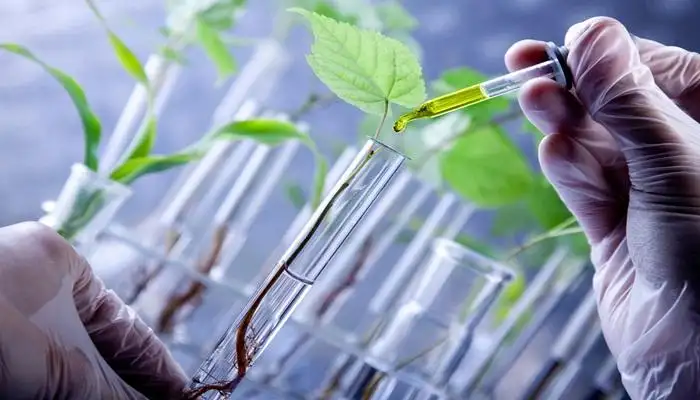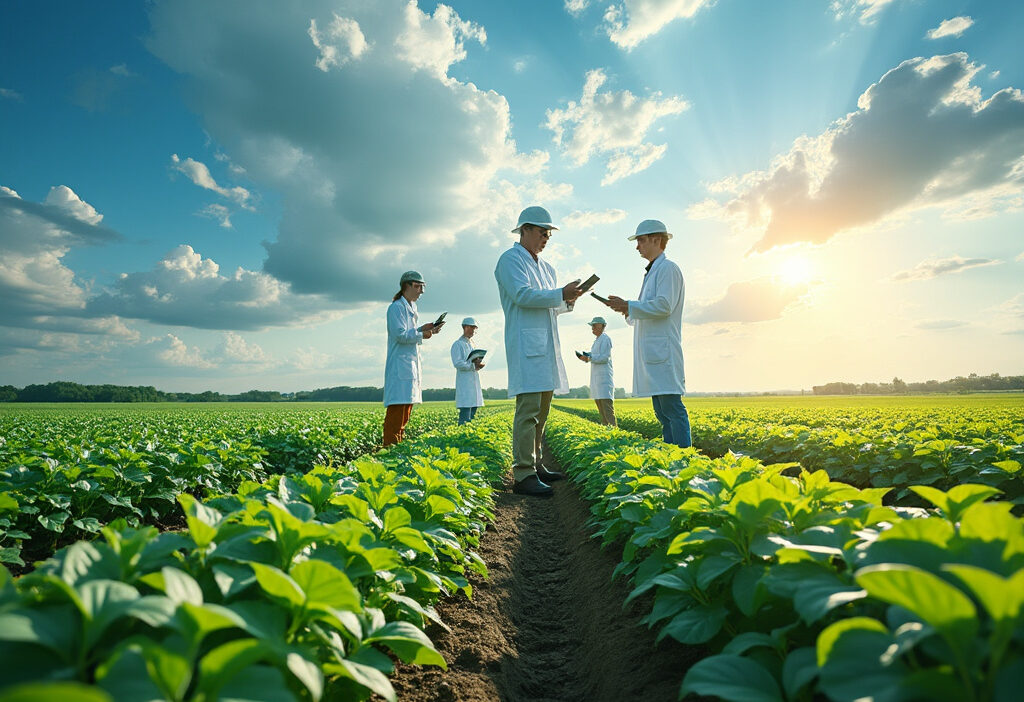Growing Smarter How Biotechnology Is Revolutionizing Modern Agriculture
Biotechnology is transforming modern agriculture by introducing innovative solutions to age-old farming challenges. From genetically modified crops that resist pests to precision farming techniques that optimize resource use, biotechnological advancements are making agriculture more sustainable and productive. This article delves into how these scientific breakthroughs are reshaping the agricultural landscape, offering insights into their benefits, challenges, and future potential.
The Genesis of Agricultural Biotechnology
The roots of agricultural biotechnology stretch back thousands of years, long before the term itself was coined. Early farmers practiced selective breeding, choosing plants and animals with desirable traits to propagate the next generation. This empirical approach laid the groundwork for modern biotechnology, though the science behind it remained a mystery until the 19th century. Gregor Mendel’s experiments with pea plants in the 1860s revealed the principles of heredity, unlocking the first scientific understanding of genetic inheritance.
The 20th century marked a turning point with the discovery of DNA’s structure in 1953 by Watson and Crick. This breakthrough paved the way for recombinant DNA technology in the 1970s, enabling scientists to directly manipulate genetic material. The first genetically modified (GM) plant, an antibiotic-resistant tobacco, was created in 1983, demonstrating that genes could be transferred between species. By the 1990s, commercial GM crops like Flavr Savr tomatoes and Bt cotton entered the market, showcasing biotechnology’s potential to enhance agriculture.
Key milestones in agricultural biotechnology include:
- 1986: First field trials of GM crops in the U.S. and France.
- 1996: Commercialization of herbicide-resistant soybeans, revolutionizing weed control.
- 2000s: Advances in CRISPR-Cas9 gene editing, allowing precise modifications without foreign DNA insertion.
The shift from traditional breeding to genetic engineering accelerated as scientists moved beyond random mutations to targeted trait improvements. While early methods relied on cross-species gene transfers, newer techniques like RNA interference and synthetic biology enable even finer control over plant characteristics. This evolution reflects biotechnology’s growing sophistication, setting the stage for today’s innovations in crop resilience and sustainability.
As the field progressed, regulatory frameworks emerged to address safety and ethical concerns, ensuring responsible development. The journey from rudimentary selection to precision gene editing underscores biotechnology’s transformative role in agriculture—a foundation for the next chapter’s exploration of genetic engineering’s impact on crop enhancement.
Genetic Engineering and Crop Improvement
Genetic engineering has emerged as a transformative force in modern agriculture, enabling scientists to precisely modify crop genomes to enhance desirable traits. Unlike traditional breeding, which relies on cross-pollination and selection over generations, genetic engineering allows for the direct insertion, deletion, or alteration of specific genes. This precision accelerates the development of crops with improved yield, resilience, and nutritional value.
One of the most notable successes is Bt cotton, engineered to produce a protein from the bacterium Bacillus thuringiensis that is toxic to certain pests. This innovation has drastically reduced pesticide use while boosting yields for farmers worldwide. Similarly, Golden Rice, fortified with beta-carotene, addresses vitamin A deficiency in regions where rice is a dietary staple. These examples underscore biotechnology’s potential to tackle both productivity and public health challenges.
Beyond pest resistance and nutrition, genetic engineering has enabled crops to withstand environmental stressors. Drought-tolerant maize, for instance, incorporates genes that help plants retain water under arid conditions, safeguarding harvests in climate-vulnerable areas. Meanwhile, CRISPR-Cas9 gene editing is pushing boundaries further, allowing for non-transgenic modifications that avoid regulatory hurdles while still delivering traits like disease resistance or enhanced shelf life.
Critics raise concerns over biosafety and ethical implications, yet rigorous testing ensures GM crops meet stringent standards before commercialization. As the demand for sustainable food systems grows, genetic engineering remains a cornerstone of agricultural innovation, bridging the gap between traditional practices and the data-driven precision farming techniques explored in the next chapter. The synergy between these approaches promises a smarter, more resilient future for global agriculture.
Precision Agriculture and Biotechnology
Precision agriculture represents a paradigm shift in farming, leveraging biotechnology alongside advanced technologies like data analytics, drones, and IoT devices to maximize efficiency and sustainability. By integrating these tools, farmers can make data-driven decisions that optimize resource use, reduce waste, and enhance crop performance—complementing the genetic advancements discussed earlier.
At the core of precision agriculture is biotechnology-enabled data analytics. Sensors embedded in fields collect real-time data on soil moisture, nutrient levels, and plant health, which is then analyzed using machine learning algorithms. These insights allow farmers to apply water, fertilizers, and pesticides with pinpoint accuracy, minimizing environmental impact while boosting yields. For example, genetically modified crops engineered for drought resistance can be paired with soil moisture sensors to ensure irrigation is applied only when necessary, conserving water without compromising growth.
Drones and satellite imaging further refine precision farming. Equipped with multispectral cameras, drones capture detailed crop health maps, identifying areas affected by pests or disease before visible symptoms appear. This early detection enables targeted interventions, reducing the need for blanket chemical applications—a theme that will be expanded in the next chapter. Meanwhile, IoT devices, such as smart irrigation systems, automate responses to environmental changes, ensuring optimal growing conditions with minimal human intervention.
The synergy between biotechnology and precision tools is transforming agriculture into a highly efficient, sustainable practice. By merging genetic innovations with real-time monitoring and automation, farmers are not only growing more but growing smarter—ushering in an era where every seed, drop of water, and nutrient is utilized to its fullest potential.
Biotech Solutions for Pest and Disease Control
Biotech Solutions for Pest and Disease Control
Building on the precision-driven approaches discussed earlier, biotechnology is now transforming pest and disease management with groundbreaking innovations that minimize chemical pesticide use. Traditional methods often rely on broad-spectrum pesticides, which harm beneficial organisms and contribute to environmental degradation. In contrast, biotech solutions offer targeted, sustainable alternatives that align with eco-friendly farming goals.
One of the most promising advancements is the development of RNA interference (RNAi) technology. By designing RNA molecules that silence specific genes in pests, scientists can disrupt their life cycles without affecting non-target species. For example, RNAi-based sprays have been successfully used to combat the Colorado potato beetle, reducing crop damage while preserving pollinators like bees.
Another breakthrough is the use of genetically modified (GM) crops with built-in resistance to pests and diseases. Bt crops, engineered to produce insecticidal proteins from Bacillus thuringiensis, have significantly lowered pesticide applications in cotton and maize farming. Similarly, CRISPR-edited crops are being developed to resist viral infections, such as the devastating cassava mosaic virus, which threatens food security in Africa.
Biotech also leverages microbial biocontrol agents. Beneficial bacteria and fungi, like Beauveria bassiana or Pseudomonas fluorescens, are deployed to outcompete or neutralize pathogens. These microbes can be tailored to specific crops and pests, offering a precision tool for integrated pest management (IPM).
By reducing chemical inputs, these biotech solutions not only protect ecosystems but also lower production costs and enhance crop resilience. As the next chapter will explore, such innovations are part of a broader shift toward sustainable farming, where biotechnology plays a pivotal role in balancing productivity with environmental stewardship.
Sustainable Farming Through Biotech
Biotechnology is driving a paradigm shift in sustainable farming, equipping agriculture with tools to thrive amid climate challenges while minimizing environmental impact. Unlike traditional methods that often deplete resources, biotech innovations focus on resilience and efficiency, ensuring food security without compromising ecosystems.
One breakthrough is the development of drought-resistant crops, engineered to withstand water scarcity by enhancing root systems or modifying stomatal regulation. For example, scientists have introduced genes from drought-tolerant plants like Agrobacterium into staples such as maize and wheat, enabling them to maintain yield under arid conditions. This reduces irrigation demands, conserving freshwater reserves—a critical advantage as global water stress intensifies.
Another key advancement is biofertilizers, which replace synthetic nitrogen fertilizers responsible for significant greenhouse gas emissions. These microbial inoculants, such as nitrogen-fixing Rhizobia, form symbiotic relationships with plant roots, converting atmospheric nitrogen into usable nutrients. Similarly, phosphate-solubilizing bacteria unlock soil-bound phosphorus, enhancing uptake while preventing runoff pollution. Field trials show biofertilizers can cut synthetic fertilizer use by up to 30%, slashing both costs and environmental harm.
Biotech also optimizes resource use through precision gene editing, tailoring crops to absorb nutrients more efficiently. For instance, rice varieties with edited NRT1.1B genes exhibit improved nitrogen utilization, reducing the need for excess fertilization. Such innovations align with circular agriculture principles, where waste is minimized, and inputs are maximized.
By integrating these solutions, biotechnology is redefining sustainability—balancing productivity with planetary health. The next frontier, CRISPR, promises even finer control over these traits, accelerating the transition to smarter, greener farming.
The Role of CRISPR in Modern Agriculture
CRISPR technology has emerged as a game-changer in modern agriculture, offering unprecedented precision in gene editing to accelerate crop improvement. Unlike traditional breeding methods, which rely on time-consuming cross-pollination, CRISPR allows scientists to make targeted modifications to plant DNA, enhancing desirable traits with remarkable efficiency. This breakthrough is reshaping how we develop crops, enabling faster responses to environmental challenges and food demands.
One of CRISPR’s most significant advantages is its ability to edit genes without introducing foreign DNA, a distinction that sets it apart from earlier genetic modification techniques. By precisely snipping or altering specific sequences, researchers can enhance traits like disease resistance, drought tolerance, and nutritional content. For example, scientists have used CRISPR to develop wheat resistant to powdery mildew, a devastating fungal disease, by disabling susceptibility genes. Similarly, tomatoes have been edited to improve shelf life and flavor by tweaking ripening-related genes.
The technology also holds promise for climate-resilient agriculture. As global temperatures rise and weather patterns become erratic, CRISPR can help create crops that withstand extreme conditions. Researchers are exploring edits that boost photosynthesis efficiency, reduce water dependency, and enhance nitrogen utilization—key factors in sustainable farming. Moreover, CRISPR accelerates the domestication of wild plants, unlocking new sources of genetic diversity for future crops.
While regulatory and ethical discussions continue, CRISPR’s potential to revolutionize agriculture is undeniable. By enabling precise, rapid, and cost-effective crop improvements, it complements biotech innovations like biofertilizers and drought-resistant strains, forming a cohesive strategy for sustainable and secure food systems. The next frontier lies in scaling these advancements to ensure global food security amid growing climatic pressures.
Biotechnology and Food Security
Biotechnology is playing a pivotal role in addressing global food security by enhancing crop productivity and resilience, particularly as climate change intensifies. With the global population projected to reach nearly 10 billion by 2050, traditional farming methods alone cannot meet the escalating demand for food. Biotech innovations are filling this gap by developing crops that yield more under harsher conditions while reducing reliance on chemical inputs.
One of the most significant contributions is the development of drought-tolerant and heat-resistant crops. By identifying and modifying genes responsible for stress responses, scientists have engineered varieties of maize, wheat, and rice that thrive in arid or unpredictable climates. For example, water-efficient maize, already deployed in parts of Africa, has increased yields by up to 35% in drought-prone regions. Similarly, flood-resistant rice can survive submerged conditions for extended periods, safeguarding harvests in flood-vulnerable areas.
Beyond abiotic stress, biotechnology is combating pests and diseases through advanced solutions like RNA interference (RNAi). Unlike broad-spectrum pesticides, RNAi targets specific pests, minimizing ecological damage. Crops like the potato have been engineered to resist late blight—a devastating disease responsible for historic famines—without excessive fungicide use.
Nutrient enrichment is another critical frontier. Biofortified crops, such as Golden Rice enriched with vitamin A, address malnutrition in regions where dietary diversity is limited. These innovations are not just about quantity but also nutritional quality, ensuring food security encompasses both availability and health benefits.
As climate variability worsens, biotechnology’s ability to create hardier, more productive crops will be indispensable. However, these advancements must be balanced with ethical and regulatory scrutiny—a topic explored in the next chapter—to ensure equitable access and public trust in these transformative technologies.
Ethical and Regulatory Considerations
The rapid advancement of biotechnology in agriculture has sparked intense ethical debates and regulatory challenges. While innovations like genetically modified organisms (GMOs) and gene-edited crops promise higher yields and resilience—as explored in the previous chapter—their adoption is often met with public skepticism and complex legal hurdles. Critics argue that tampering with nature raises unintended ecological consequences, such as gene flow to wild relatives or the decline of biodiversity. Meanwhile, proponents emphasize biotechnology’s potential to reduce pesticide use and enhance nutrition, framing it as a moral imperative to combat global hunger.
Regulatory frameworks vary widely across regions, reflecting divergent public perceptions. The EU, for instance, enforces strict GMO labeling laws and precautionary principles, while the U.S. adopts a more product-based approach, focusing on safety rather than process. Emerging technologies like CRISPR-Cas9 further complicate the landscape, as their precision blurs the line between conventional breeding and genetic modification. Should these crops face the same stringent regulations as traditional GMOs, or do they warrant a new classification?
Public perception remains a significant barrier. Misinformation and fearmongering have led to widespread distrust, despite scientific consensus on the safety of approved biotech crops. The labeling debate exemplifies this tension: while transparency is crucial, mandatory GMO labels may inadvertently stigmatize beneficial technologies. Balancing consumer rights with scientific progress requires nuanced policymaking and robust public education.
As the next chapter will explore, these ethical and regulatory challenges directly influence the economic viability of biotech solutions. Without clear guidelines and public trust, even the most promising innovations risk stagnation, hindering their potential to transform agriculture sustainably.
The Economic Impact of Agricultural Biotechnology
The adoption of agricultural biotechnology has reshaped the economic landscape of farming, offering both transformative benefits and complex challenges. For large-scale farmers, biotech crops like Bt cotton and herbicide-resistant soybeans have significantly boosted yields while reducing input costs. Studies show that genetically modified (GM) crops can increase productivity by up to 22%, with corresponding reductions in pesticide use by 37%. These efficiencies translate into higher profit margins, enabling agribusinesses to reinvest in precision farming tools and sustainable practices. However, the high upfront costs of patented seeds and specialized equipment can create barriers for smaller operations, exacerbating economic disparities.
Smallholder farmers, particularly in developing nations, face a dual reality. While biotech solutions like drought-tolerant maize have improved resilience in regions like sub-Saharan Africa, limited access to credit and infrastructure often hinders adoption. Additionally, dependency on corporate seed suppliers raises concerns about long-term financial sovereignty. Yet, initiatives like open-source biotechnology and public-private partnerships are emerging to bridge this gap, offering affordable, locally adapted solutions.
The broader economic impact extends beyond the farm. Biotechnology has spurred job creation in research, logistics, and agro-processing sectors, while reducing post-harvest losses through innovations like CRISPR-edited, non-browning produce. However, trade disputes over GM crop approvals and intellectual property rights continue to disrupt global markets, underscoring the need for harmonized policies. As the industry evolves, balancing scalability with inclusivity will be critical to ensuring that biotech’s economic benefits reach all stakeholders—without repeating the regulatory pitfalls discussed earlier or overlooking the transformative potential of future innovations on the horizon.
The Future of Biotechnology in Agriculture
The future of biotechnology in agriculture promises unprecedented advancements that could redefine how we grow, process, and distribute food. Emerging technologies like CRISPR-Cas9 and RNA interference (RNAi) are poised to accelerate crop improvement, enabling precise edits to plant genomes without introducing foreign DNA. This could lead to crops with enhanced drought tolerance, disease resistance, and nutritional profiles—addressing climate change and malnutrition simultaneously.
Another frontier is synthetic biology, where scientists engineer microorganisms to produce fertilizers or pesticides naturally, reducing reliance on chemical inputs. Imagine soil bacteria that fix nitrogen more efficiently or fungi that protect roots from pathogens—these innovations could slash costs while boosting sustainability.
Vertical farming and lab-grown meat are also converging with biotech. Genetically optimized plant varieties tailored for indoor agriculture could maximize yields in urban farms, while cellular agriculture might revolutionize protein production, reducing the environmental footprint of livestock.
Data-driven biotech is another game-changer. AI-powered gene sequencing can predict which genetic combinations will yield the hardiest crops, speeding up breeding cycles. Meanwhile, blockchain could ensure transparency in biotech supply chains, from seed to shelf, building consumer trust.
However, challenges remain. Regulatory frameworks must evolve to keep pace with these innovations, ensuring safety without stifling progress. Public acceptance will also be critical, as skepticism around GMOs persists. Yet, if these hurdles are overcome, biotechnology could usher in an era of hyper-efficient, sustainable farming, transforming agriculture from a resource-intensive industry into a precision-driven, eco-conscious system. The next decade may well determine whether we can harness these tools to feed a growing planet without exhausting it.

Conclusions
Biotechnology holds the promise of revolutionizing agriculture by addressing critical issues like food security, environmental sustainability, and crop resilience. While challenges such as ethical concerns and regulatory hurdles remain, the potential benefits are undeniable. As we continue to innovate, the integration of biotechnology in farming practices will be pivotal in feeding the growing global population sustainably.



